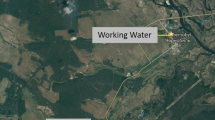Abstract
Experiments were designed to assess the effect of different techniques of radiotracer labelling on subsequent radioisotope excretion rates in marine crustaceans. A small amphipod (Gammarus locusta) that accumulated 65Zn under a close approximation of natural conditions excreted the radiotracer during a 3-month period at a markedly different rate than those of comparable amphipods labelled with 65Zn in the laboratory via different combinations of radioactive food and seawater. Shrimp (Lysmata seticauda) administered 65Zn by three different methods in the laboratory displayed different excretion kinetics during the first 2 months of loss. The difference between excretion rates most likely was a reflection of the degree to which the various zinc pools within the shrimp had equilibrated with the radiotracer. During the next several months all 65Zn loss rates were quite similar, probably indicating that radiotracer excretion was taking place from similar zinc pools within the shrimp. The importance of adequate radiotracer labelling techniques as well as proper design of subsequent excretion experiments, used to gain reliable information on flux rates of the corresponding stable metal, is discussed. It is concluded that laboratory radiotracer experiments which are intended to supply information on actual situations in the sea require careful design and execution.
Similar content being viewed by others
Literature Cited
Anonymous: Design of radiotracer experiments in marine biological systems. Int. atom. Energy Ag. tech. Rep. Ser. (In press)
Baptist, J.P., D.E. Hoss and C.W. Lewis: Retention of 51Cr, 59Fe, 60Co, 65Zn, 85Sr, 95Nb, 141mIn and 131I by the Atlantic croaker (Micropogon undulatus). Hlth Phys. 18, 141–148 (1970)
Bernhard, M., A. Bruschi and F. Möller: Use of compartmental models in radioecological laboratory studies. In: Design of radiotracer experiments in marine biological systems. Int. atom. Energy Ag. tech. Rep. Ser. (In press)
Bowen, V.T., J.S. Olsen, C.L. Osterberg and J. Ravera: Ecological interactions of marine radioactivity. In: Radioactivity in the marine environment, pp 200–222. Washington, D.C.: National Academy of Sciences 1971
Cutshall, N.: Turnover of zinc-65 in oysters. Hlth Phys. 26, 327–331 (1974)
Fowler, S.W. and G. Benayoun: Experimental studies on cadmium flux through marine biota. In: Comparative studies of food and environmental contamination, pp 159–178. Vienna: International Atomic Energy Agency 1974
—, L.F. Small and J.M. Dean: Experimental studies on elimination of zinc-65, cesium-137 and cerium-144 by euphausiids. Mar. Biol. 8, 224–231 (1971)
Kane, J., S. Kečkeš and A. Veglia: Errors in the extrapolation of laboratory experiments to field conditions. Rapp. P.-v. Réun. Commn. int. Explor. Scient. Mer Méditerr. 20, 751–753 (1972)
Kečkeš, S., B. Ozretić and M. Krajnović: Loss of Zn65 in the mussel Mytilus galloprovincialis. Malacologia 7, 1–6 (1968)
Kuenzler, E.J.: Elimination of iodine, cobalt, iron and zinc by marine zooplankton. In: Symposium on radioecology, pp 462–473. Ed. by D.J. Nelson and F.C. Evans. Oak Ridge, USAEC Technical Information Division 1969
Lowman, F.G., T.R. Rice and F.A. Richards: Accumulation and redistribution of radionuclides by marine organisms. In: Radioactivity in the marine environment, pp 161–199. Washington, D.C.: National Academy of Sciences 1971
Renfro, W.C.: Radioecology of 65Zn in an arm of the Columbia River estuary, 88 pp. Ph. D. thesis, Oregon State University 1968
—: Transfer of 65Zn from sediments by marine polychaete worms. Mar. Biol. 21, 305–316 (1973)
— and S.W. Fowler: General recommendation for designing marine radioecological experiments. Hlth Phys. 24, 572–573 (1973)
Seymour, A.H.: Accumulation and loss of zinc-65 by oysters in a natural environment. In: Disposal of radioactive wastes into seas, oceans and surface waters, pp 605–619. Vienna: International Atomic Energy Agency 1966
— and V.A. Nelson: Decline of 65Zn in marine mussels following the shutdown of Hanford reactors. In: Radioactive contamination of the marine environment, pp 277–286. Vienna: International Atomic Energy Agency 1973
Small, L.F., S.W. Fowler and S. Kečkeš: Flux of zinc through a macroplanktonic crustacean. In: Radioactive contamination of the marine environment, pp 437–452. Vienna: International Atomic Energy Agency 1973
Ünlü, M.Y., M. Heyraud and S. Kečkeš: Mercury as a hydrospheric pollutant. I. Accumulation and excretion of 203HgCl2 in Tapes decussatus L. In: Marine pollution and sea life, pp 292–295. Ed. by M. Ruivo (F.A.O). London: Fishing News (Books) Ltd. 1972
Van Weers, A.W.: Uptake and loss of 65Zn and 60Co by the mussel Mytilus edulis L. In: Radioactive contamination of the marine environment, pp 385–401. Vienna: International Atomic Energy Agency 1973
Young, D.R. and T.R. Folsom: Loss of 65Zn from the California sea-mussel Mytilus californianus. Biol. Bull. mar. biol. Lab., Woods Hole. 133, 438–447 (1967)
Author information
Authors and Affiliations
Additional information
Communicated by J.M. Pérès, Marseille
Rights and permissions
About this article
Cite this article
Fowler, S.W., La Rosa, J., Heyraud, M. et al. Effect of different radiotracer labelling techniques on radionuclide excretion from marine organisms. Marine Biology 30, 297–304 (1975). https://doi.org/10.1007/BF00390635
Accepted:
Issue Date:
DOI: https://doi.org/10.1007/BF00390635




